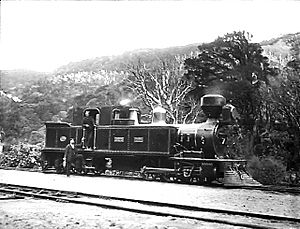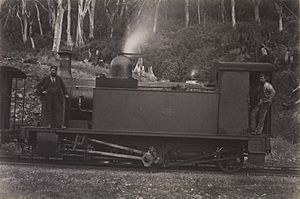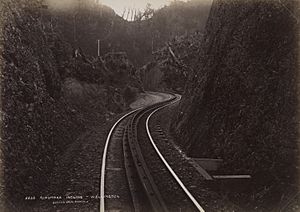Rimutaka Incline facts for kids
Quick facts for kids Rimutaka Incline |
|
|---|---|
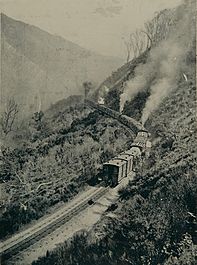
The long slow climb up the centre rail
|
|
| Overview | |
| Status | Closed |
| Owner | New Zealand Railways Department |
| Locale | |
| Termini | Cross Creek Summit |
| Stations | 2 |
| Service | |
| System | New Zealand Government Railways (NZGR) |
| Operator(s) | New Zealand Railways Department |
| Rolling stock | NZR H class (primary motive power) |
| History | |
| Opened | 1878-10-16 |
| Closed | 1955-10-30 |
| Technical | |
| Line length | 3 mi (4.8 km) |
| Track length | 3 mi (4.8 km) |
| Number of tracks | Single |
| Character | Rural |
| Rack system | Fell (not a rack system) |
| Track gauge | 3 ft 6 in (1,067 mm) |
| Highest elevation | 1,141 feet (348 m) |
| Maximum incline | 6.667% |
The Rimutaka Incline was a unique railway line in New Zealand. It was about 3-mile-long (4.8 km) and had a special track width of 3 ft 6 in (1,067 mm). This railway used the Fell system to climb a very steep hill. The line connected Summit and Cross Creek stations. These stations were on the Wairarapa side of the original Wairarapa Line in the Wairarapa area.
People sometimes incorrectly use "Rimutaka Incline" for other parts of the old Wairarapa Line. This line ran between Upper Hutt and Speedy's Crossing, near Featherston. Today, the path of the old incline is part of the Remutaka Rail Trail. It is a popular walking and biking track.
Contents
History of the Rimutaka Incline
Why the Incline Was Built
In 1871, the government decided to build a railway from Wellington to Masterton. Julius Vogel, a government leader, traveled to England to get money for this big project. He also visited the United States to learn about their railway systems.
Engineers then started looking for the best way to build the railway over the Rimutaka Range. This mountain range is now spelled "Remutaka Range". They looked at four different routes. All the plans included a section from Upper Hutt to Kaitoke (now Kaitoke).
One idea was to build a long tunnel. This tunnel would be about 2.6 kilometres (1.6 mi) long. It would help the train go through the mountains. However, this plan would need very steep slopes on either side of the tunnel.
Another idea was called the Birch Spur Incline. This plan involved using ropes to pull trains up a steep slope. But engineers could not find a good place for this rope system. So, this idea was also dropped.
The final choice was a three-mile (4.8 kilometres (3.0 mi)) incline. It would have very steep slopes, averaging 1 in 15. This meant the track would rise 1 meter for every 15 meters it traveled. This was the most practical option for engineers.
The head of the Public Works Department, John Carruthers, made the final decision. He chose the Fell system. This system uses a special center rail for both pulling and braking. It was a proven system, meaning it had worked elsewhere. The Rimutaka Incline became the third and longest-lasting Fell system of its kind.
Building the Rimutaka Incline
Building the Rimutaka Incline involved two main contracts. These were called the Summit contract and the Incline contract.
Summit Contract Work
This contract covered the area around Summit station. It included digging out the station yard and building the Summit tunnel. Work started in 1874 and was supposed to finish by 1876.
The Summit yard was a large area dug into the hillside. It was about 120 feet (37 m) wide and 500 yards (460 m) long. Workers removed a lot of dirt to make a flat space. Houses were also built on the hillside above the yard.
The Summit tunnel was a big challenge. It was about 15 feet (4.6 m) high and 12 feet (3.7 m) wide at its widest point. It took three and a half years to complete. After the rails were laid, the Public Works Department lined the tunnel. This lining helped make it safe. Sadly, one worker died during this part of the construction. The Summit contract finished in December 1877, behind schedule.
Incline Contract Work
The Incline contract was given to Charles McKirdy in 1875. This contract was for building the railway path itself. It stretched from Summit tunnel all the way to Featherston. This was a distance of about 14.403 kilometres (8.950 mi). It also included the Cross Creek station yard.
The line went down a steep slope of 1 in 15. It passed through the 396-foot (121 m) long Horseshoe Gully Tunnel, later called Siberia Tunnel. After the tunnel, the line crossed a gully on a huge earth and rock bank. This bank was about 90 feet (27 m) high.
The line continued its steep descent to Cross's Creek (later Cross Creek) station. From there, it went down gentler slopes to Featherston. Building the lower tunnel, called Price's, was difficult. The rock was unstable, and there were accidents. Two men died in a cave-in there in 1876.
Track laying on the incline began in April 1878. It reached Cross Creek the next month. An H class locomotive was used to pull work trains. Charles McKirdy ran out of time and money. Other people finished the contract, and the track reached Featherston in September 1878. The entire contract was completed 13 months late.
How the Incline Operated
At first, only one locomotive pulled trains up the incline. Later, two locomotives were used. By 1887, trains used multiple locomotives, each pulling its own share. The maximum weight a train could carry increased over time. By 1908, trains could carry up to 260 tons going up.
Special Fell brake vans were used to help control the trains. These vans had strong brakes that pressed on the center rail. The brake blocks wore out very quickly. For trains going down, a Fell van was placed at the front, behind the locomotives. If the train was very heavy, a second Fell van was added at the back.
After 1903, a new braking system called the Westinghouse air brake was added. This allowed trains to use up to five locomotives. Passenger trains going downhill could use up to five Fell brake vans. Each brake van needed its own guard to operate the brakes. A train with many locomotives and brake vans needed a large crew.
Safety was very important. Cross Creek station had a special "safety siding." If a train coming down the incline had a problem, it could be directed onto this siding to stop safely. Drivers would blow a long whistle to signal that everything was fine.
The Rimutaka Incline also carried important passengers. Four royal trains traveled on the line. These included trains for the Prince of Wales, the Duke and Duchess of York, the Duke of Gloucester, and Queen Elizabeth II with the Duke of Edinburgh.
The H class locomotives were specially designed for the incline. They usually only operated on this section of the railway. They could travel to workshops for repairs, but only at slow speeds. Later, they were allowed to travel to Featherston to help push trains.
Train speeds on the incline were carefully controlled. The speed limit changed over the years. Eventually, it was 6 mph (9.7 km/h) going up and 10 mph (16 km/h) going down.
Other types of locomotives were sometimes used to help the H class engines. These included W class and WE class locomotives. The E class and WG class engines also helped out.
The H class locomotives traveled many miles. Their mileage increased when the railway line was extended to other towns. In 1906–07, they traveled over 64,000 miles in a year. This was like making 1,780 return trips on the incline.
In 1936, special Wairarapa railcars were introduced. These lightweight trains were built specifically for the incline. They were named after famous Maori canoes. They were faster than the old trains, greatly speeding up passenger travel. These railcars were very popular until the incline closed in 1955.
Replacing the Incline
For many years, people looked for a better way to cross the Rimutaka Range. After World War II, a new route was chosen. This route involved building a long tunnel between Maymorn and Lucena's Creek.
Construction of the new tunnel started in 1948. It was finished in 1955. The new tunnel and railway line opened on November 3, 1955. This was just five days after the Rimutaka Incline closed forever.
The old incline was quickly taken apart. The tracks were removed by March 1956. The H 199 locomotive helped pull the work trains that removed the tracks. The buildings at the stations were sold. Some of the rails and Fell brake vans were sent to another incline railway. Five of the six H class locomotives were scrapped.
The Rimutaka Incline Today
Fell Engine Museum
A museum was opened in Featherston in 1984. It is dedicated to the only remaining H-class "Fell" locomotive, H 199. This locomotive had been on display in a local park since 1958. The museum also has F 210, the only remaining Fell brake van.
Remutaka Rail Trail
After a book was published in 1976 and the Fell Engine Museum opened, people became interested in the incline again. In 1984, the New Zealand Forest Service made it possible to visit Cross Creek.
In 1987, the Remutaka Rail Trail officially opened. This trail uses the path of the old railway line from Cross Creek to Kaitoke. It is now a very popular place for recreation. It is part of the Remutaka Forest Park.
Children's Book
The H 199 locomotive inspired a children's book. In 2013, Joy Cowley wrote Hero of the Hill. The book tells the story of the train's journey up the incline during a stormy night.
Future Plans
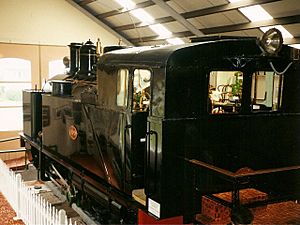
In 2005, former railway staff and friends gathered in Featherston. They visited Cross Creek to remember 50 years since the last train ran on the incline. On the same day, a ceremony marked the start of a new project. The Rimutaka Incline Railway Heritage Trust plans to rebuild parts of the railway.
The trust was formed in 2003. They want to bring the railway back in four stages. Their main base is at Maymorn. Much of the original railway path has been saved. The trust plans to use this path for the rebuilt railway.
Currently, the project is in its first stage. They are getting old trains to restore. They are also building fences, laying tracks in the yard, and constructing a shed for the rail vehicles.



